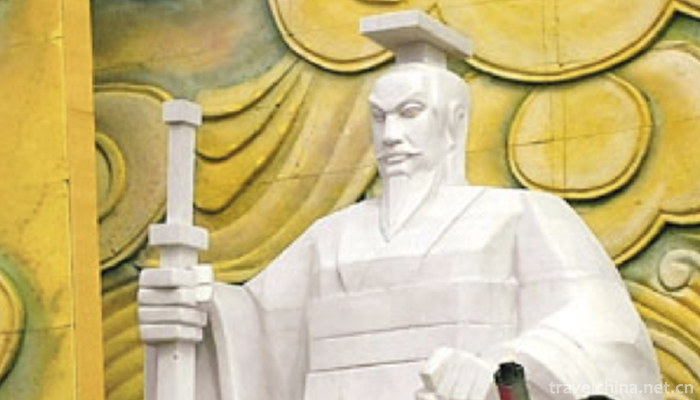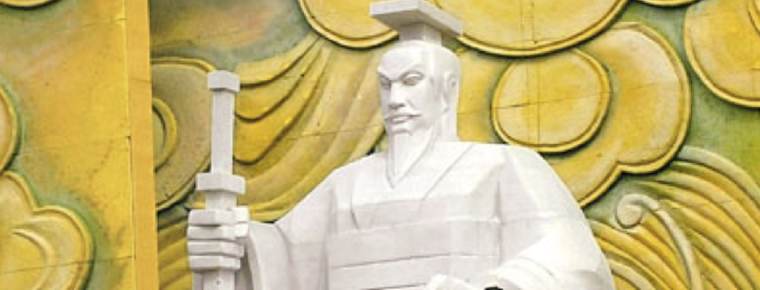Huang Di memorial ceremony
Huang Di memorial ceremony
Yellow Emperor's sacrificial ceremony is a kind of sacrificial music and dance to celebrate Xuanyuan Huangdi's pioneering achievements in Chinese civilization. The theme of the ceremony is to praise Huangdi's merits, inherit national memory, protect spiritual homeland and build a harmonious China. The ceremony will include beating drums, ringing bells, offering flower baskets, reading sacrifices, music and dance, and paying homage to ancestral mausoleums. Among them, "Sacrifice Music and Dance" as an important part of the ceremony of the Yellow Emperor in the Qing and Ming Dynasties, was unanimously praised by Chinese, overseas Chinese and domestic experts and scholars. The whole scene is magnificent, and it is a wonderful chapter in the public sacrifice. Xuanyuan Song is composed of Preface Ceremony, Cloud Gate and Dragon Chronicle.
On June 7, 2008, the Huangdi Festival was approved by the State Council to be included in the second batch of national intangible cultural heritage list.
The origin of the ceremony
Xinzheng is the hometown of Huangdi, the birthplace and capital of Xuanyuan Huangdi. Huangdi, the ancestor of humanities, established Bear State in Xinzheng. Since 2006, the Yanhuang Cultural Tourism Festival, originally sponsored by the People's Government of Xinzheng City, Henan Province, has been upgraded to the grand ceremony of worshiping ancestors in Huangdi's hometown.
” On March 3, the Origin of Bai Xuanyuan
Legend has it that March 3rd is the birthday of the Yellow Emperor. Since ancient times, there has been a saying that "February 2nd, the Dragon rises up; March 3rd, the birth of Xuanyuan" in China. Emperor Xuanyuan was respected as the ancestor of Chinese culture and the common ancestor of Chinese descendants. According to historical records, Xinzheng City in Henan Province was called Xiong Guo during the Huangdi Period. There are more than 20 cultural relics of Huangdi. It is the place where Huangdi was born, started his business and built his capital. In this area, Emperor Xuanyuan reinvigorated the army, caressed all the people, passed all directions, and merged with Emperor Yan to unify the world.
In the Spring and Autumn Period, Zheng's famous Xiangzichan made this folk activity further developed and flourished. On March 3rd, a pilgrimage to Xuanyuan Huangdi was launched in Mount Tientz (located in Xinzheng City, a relic of Huangdi's activities), and the folk custom continued.
About 5,000 years ago, the Yellow Emperor unified the Yellow River basin by uniting other tribes and laid the basic pattern of Chinese culture. Located in the southern part of the Loess Plateau, the Mausoleum of the Yellow Emperor is the legendary clothes and crowns of the Yellow Emperor. In 1961, it was declared as a national key cultural relic protection unit and has the reputation of "the first Mausoleum of China".
Since ancient times, folk proverbs such as "February 2, Dragon Head up", "March 3, Bai Xuanyuan" have been widely spread. As the hometown of Emperor Xuanyuan and Huangdi, Xinzheng has been clearly recorded in the official history of the Warring States Period of Bamboo Books and Records of History of the Han Dynasty. In the historical books of the Spring and Autumn Period, there is a record of worshipping the Yellow Emperor on March 3rd in Xinzheng Mount Fuci (commonly known as "Shizu Mountain"). After the Tang Dynasty, it became a rule gradually. The prosperous times were worshipped by the officials, and the troubled times were run by the people themselves. Year after year, it has lasted to this day.
The Yellow Emperor was a great tribal leader at the end of primitive society in China, and was the ancestor of the Chinese nation's civilization. He made weapons and bows and arrows for boats and boats. His wife was able to raise silkworms. His historian Cangjie created words, his minister Zhu created the Ganzhi calendar, and his musician Linglun made musical instruments. Later, China was able to stand tall among the four ancient civilizations in the world, which could not be separated from Huangdi's great nobility. The Yellow Emperor also recorded in the annals of history his great achievements in punishing evil and uniting the Chinese nation for the first time. It is said that Huangdi lived 118 years. On one occasion, during his tour of Henan Province, suddenly a thunderbolt broke out on a sunny day and a yellow dragon fell from the sky. He said to the Yellow Emperor, "Your mission has been completed. Please go to heaven with me. "The Yellow Emperor knew his destiny was hard to violate, so he went up to the dragon's back. When Huanglong flew over Qiaoshan in Shaanxi Province, Huangdi asked to drive down to comfort his subjects. The people of Li came from all directions, crying bitterly. Under the repeated urging of Huanglong, Huangdi stepped onto the dragon's back again, and people grabbed Huangdi's skirt and held it back again and again. Huanglong took away the Yellow Emperor, leaving only his clothes. People buried Emperor Huangdi's clothes in Qiaoshan and built tombs as mausoleums. This is the origin of the legendary Mausoleum of the Yellow Emperor
Present situation of the memorial ceremony
Since the 1990s, the Xinzheng Municipal Government has followed the historical regulation to hold ancestor worship activities on the third day of March every year, and then upgraded to be the host of the Zhengzhou Municipal Government. In September 2005, provincial Party committees and provincial governments decided to upgrade to provincial sponsorship, specifically to be sponsored by the Provincial Political Consultative Conference and undertaken by the Zhengzhou Municipal Government.
Three grand ceremonies are auspicious. Rainbow in C, auspicious in Ding Hai and happy rain in E Zi touched the whole country and affected the world. Every year, several leaders of the state attend the ceremony, including representatives of the central government, provinces, municipalities and autonomous regions, and well-known guests at home and abroad. The celebration of ancestor worship has attracted worldwide attention because of its strong Chinese media broadcasting and broadcasting in three-dimensional space. Chinese at home and abroad acknowledge that Henan is the "home of the hearts of all Chinese children" and that the celebration of ancestor worship is a grand ceremony that attracts the attention of millions of Chinese people all over the world. The Grand National reunion festival in the Central Plains is a harmonious festival to show China's brilliant meteorology in the prosperous times, and the grand ceremony of worshipping ancestors is recognized by the society. Henan's popularity and reputation have been enhanced, which effectively integrates the rich resources of culture, tourism and cultural relics. The activities of attracting investment have also taken advantage of the situation. Especially, the central government regards the grand ceremony of worshipping ancestors in the hometown of the Yellow Emperor as a global celebration of Chinese people seeking their roots and worshipping ancestors Another brand-new platform of promoting tradition independently has extraordinary value and significance, and the worship ceremony for ancestors is rewarded by the Central Plains.
Procedure of ancestor worship ceremonies
The nine ceremonies in the core content of the ancestor worship ceremony follow the historical regulations and inject new elements at the same time. Especially after three years of excavation, integration, exploration and practice, they have been perfected and become the norms to be abided by every time. They are as follows: celebration gun, flower basket, incense on clean hands, worship, worship of worship, worship of worship, chant, music and dance, worship of heaven, earth and people, sacred fire prayer. Blessing.


-
1.Penglaige tourist area
Penglaige Scenic Area, located in Danya Mountain, northwest of Penglai City, Shandong Province, is a national AAAAA-level tourist attraction with an area of 18,500 square meters
Time 2018-12-08 -
2.Three Gorges Household Scenic Area
Three Gorges Household Scenic Area, National AAAAA Class Tourist Area, the First Batch of Civilized Scenic Area in Hubei Province, Top Ten Scenic Spots in Hubei Province
Time 2018-12-12 -
3.Old Stork River Drifting
Xixia Guanhe Drifting Scenic Area is a national AAAA-level tourist attraction and a part of Funiushan World Geopark in Nanyang, China. Xixia County, Nanyang City
Time 2019-01-29 -
4.Ancient town of Tangqi
Tangqi Town, located in the northern part of Hangzhou City, borders Deqing County of Huzhou City, is about 20 kilometers away from the city centre and 13 kilometers away from Linping
Time 2019-02-13 -
5.Li nationality costumes
Li costumes are mainly made of island cotton, hemp, kapok, bark fiber and silk. In ancient times, some places also used the bark of twig or bloody throat trees as clothing materials. This kind of dres
Time 2019-05-12 -
6.Firing Techniques of Liling Unglazed Colorful Porcelain
The firing technology of Liling Unglazed Five-color Porcelain, the local traditional firing technology of Liling Unglazed Five-color Porcelain in Hunan Province, is one of the national intangible cult
Time 2019-05-13 -
7.Lichuan lantern song
Lichuan Lantern Song is a traditional folk dance that originated in Baiyang area of Lichuan City. Many folk songs in Lichuan Lantern Song and the ancient bamboo branch song inherit in one continuous l
Time 2019-05-13 -
8.Uygur moulding earthenware firing
Uygur moulding pottery has a history of more than two thousand years. After the middle of the ninth century, Uygur ancestors moved westward to the vicinity of the Tarim Basin, inherited the pottery ma
Time 2019-06-26 -
9.The Custom of Hupu Women
Hupu women's custom is a traditional folk custom in Quanzhou City, Fujian Province. Hupu women are mainly distributed in the communities of Hupu, Jinzai, Houpu and Dongmei in Donghai Street, Fengze Di
Time 2019-07-09 -
10.Han Feizi
Han Feizi is a collection of works of famous thinkers and Legalists Han Fei during the Warring States period. Han Feizi was compiled by posterity after Han Fei's death. According to hanshuyiwenzhi &qu
Time 2019-09-07 -
11.Geographical environment of Guangyuan
Guangyuan City is located in the north of Sichuan Province. Its geographical coordinates are 31 ° 31 ′ n to 32 ° 56 ′ N and 104 ° 36 ′ e to 106 ° 45 ′ E. in the north, it borders Wudu County, Wen County, Ningqiang County and Nanzheng County of Shaanxi
Time 2020-12-15 -
12.Neijiang population
By the end of 2019, the total population of Neijiang's household registration was 4 million 81 thousand and 800, a decrease of 35 thousand and 900 from the end of last year, of which 2 million 103 thousand and 400 were male and 19 thousand were reduced
Time 2020-12-16